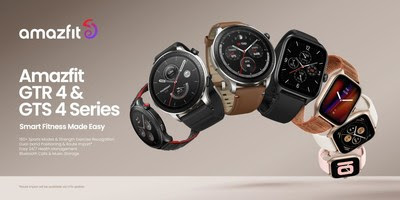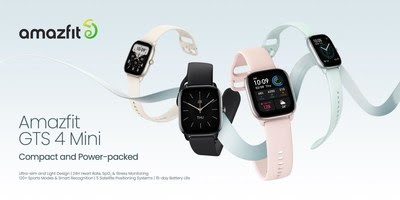BERLIN, 1er septembre 2022 /PRNewswire/ — Amazfit, une des principales marques mondiales d’accessoires portables intelligents de Zepp Health (NYSE : ZEPP), a lancé la quatrième génération de ses séries GTR et GTS à l’IFA 2022 de Berlin. Les nouvelles montres sont dotées de la technologie d’antenne GPS à polarisation circulaire qui permet un positionnement de haute précision[1], de fonctions sportives avancées et de grands écrans HD AMOLED, le tout dans un design élégant.
AMAZFIT GTR 4 ET GTS 4
Dotées de fonctions sport et santé améliorées, les montres connectées Amazfit GTR 4 et GTS 4 sont conçues pour inspirer un mode de vie professionnel et actif. Ces montres visent à aider les utilisateurs à rester en bonne santé et à suivre leurs activités et performances quotidiennes.
CARACTÉRISTIQUES SPORTIVES AVANCÉES
Les toutes nouvelles montres Amazfit sont dotées de plus de 150 modes sportifs et de fonctions de remise en forme avancées, permettant aux sportifs de suivre les données de toutes sortes d’activités. La nouvelle série reconnaît également automatiquement huit modes sportifs et intègre un nouveau mode avancé de course sur piste et un nouveau mode de swing de golf. Parallèlement, les utilisateurs peuvent synchroniser leurs données d’entraînement avec Strava, et bientôt avec adidas Running, grâce à un nouveau partenariat entre Amazfit et adidas Runtastic.
Les montres sont de parfaits compagnons de gymnastique, avec une reconnaissance intelligente de 15 exercices de musculation (25 après la mise à jour du micrologiciel) qui leur permet de compter automatiquement les répétitions, les séries et le temps de repos de l’utilisateur. Des modèles personnalisés d’entraînement par intervalles[2] pour 10 sports différents peuvent également être créés directement sur l’écran de la montre, et l’algorithme d’état d’entraînement PeakBeats développé par la marque fournira des données de performance telles que VO₂ Max après la fin de tout entraînement.
développé par la marque fournira des données de performance telles que VO₂ Max après la fin de tout entraînement.
UNE NAVIGATION IN INÉGALÉE
Les appareils GTR 4 et GTS 4 sont les premières smartwatches du secteur à intégrer la technologie d’antenne GPS à polarisation circulaire à double bande, ce qui permet d’obtenir une puissance de signal de positionnement élevée, même dans des environnements complexes.
La technologie GPS récemment mise à niveau prend en charge cinq systèmes de satellites et permet aux utilisateurs de suivre leurs mouvements en temps réel. Dans une future mise à jour du micrologiciel, la technologie prendra en charge six systèmes de satellites. Les montres prendront bientôt en charge l’importation de fichiers d’itinéraires à partir de l’application Zepp, ce qui permettra de naviguer en temps réel, directement sur la montre.
SUIVI ET GESTION AMÉLIORÉS DE LA SANTÉ
Le nouveau capteur optique PPG BioTracker 4.0 développé par nos soins est amélioré à 2LED et recueille 33 % de données en plus que la génération précédente. Associé à l’algorithme amélioré de suivi de la fréquence cardiaque des montres, l’interférence potentielle du signal causée par le mouvement du bras pendant l’exercice est considérablement réduite, ce qui permet un suivi de la fréquence cardiaque presque équivalent à celui des ceintures cardiaques.
4.0 développé par nos soins est amélioré à 2LED et recueille 33 % de données en plus que la génération précédente. Associé à l’algorithme amélioré de suivi de la fréquence cardiaque des montres, l’interférence potentielle du signal causée par le mouvement du bras pendant l’exercice est considérablement réduite, ce qui permet un suivi de la fréquence cardiaque presque équivalent à celui des ceintures cardiaques.
Ces appareils Amazfit peuvent surveiller la fréquence cardiaque, la saturation en oxygène du sang et les niveaux de stress 24 heures sur 24 et 7 jours sur 7, et peuvent tester rapidement ces trois paramètres – ainsi que la fréquence respiratoire – en seulement 45 secondes d’une seule pression, grâce à la fonction One-tap Measuring
Les montres offrent également un grand nombre de fonctions de santé supplémentaires, notamment un meilleur suivi du sommeil. Les utilisateurs peuvent désormais créer leur propre programme de sommeil en fonction de leurs habitudes de sommeil, et l’appareil identifiera le sommeil sur cette base. Ainsi, les utilisateurs qui travaillent de nuit pourront désormais surveiller leur sommeil total et leurs stades de sommeil, même pendant la journée, si un horaire de sommeil est défini.
UNE PUISSANTE BATTERIE ET UNE ASSISTANCE INTELLIGENTE
L’Amazfit GTR 4 peut durer très longtemps pendant 14 jours avec une utilisation typique. Par ailleurs, l’Amazfit GTS 4 intègre une batterie puissante qui peut durer plus d’une semaine en utilisation normale, dans son corps ultra-mince.
Ces montres Amazfit intègrent l’assistant vocal Alexa[3] pour les commandes vocales en ligne, ainsi que le stockage de musique et la lecture autonome de musique lors des séances d’entraînement en mode mains libres. Elles disposent également d’un haut-parleur intégré et de la possibilité de diffuser des données en temps réel en mode sport, comme la fréquence cardiaque, la durée et la distance de l’entraînement, et même des rappels d’hydratation, via le haut-parleur ou les écouteurs Bluetooth de l’utilisateur.
DESIGN RAFFINÉ
La quatrième génération des séries Amazfit GTR et GTS se décline en plusieurs palettes de couleurs, apportant style, texture et compacité.
L’Amazfit GTR 4 est doté d’un design haut de gamme qui comprend une lunette en verre antireflet, un cadre central métallique et une couronne classique inspirée des voitures de sport, ce qui en fait le compagnon idéal pour ceux qui veulent être élégants au bureau. La montre peut également se targuer de proposer plus de 200 cadrans de montre avec des designs correspondants toujours actifs, dont plus de 30 cadrans de montre animés et quatre nouveaux cadrans de montre interactifs. Elle se décline en trois superbes couleurs, dont Superspeed Black, Vintage Brown Leather et Racetrack Grey.
L’Amazfit GTS 4 adopte une structure mince et légère de 9,9 mm et 27 g, avec un cadre central en alliage d’aluminium et une couronne de navigation exquise en forme de pierre précieuse. Cet appareil à la pointe de la mode est également doté d’un écran HD AMOLED ultra-large de 1,75 pouce pour une interaction fluide et sans faille et bénéficie d’un rapport écran/corps impressionnant de 72,8 % et de 341 ppi. L’écran de la montre peut être visible à tout moment grâce à l’affichage permanent, et il est possible de choisir parmi plus de 150 cadrans de montre. La montre connectée est disponible en quatre couleurs vives : Infinite Black, Misty White, Autumn Brown et Rosebud Pink.
MISE À JOUR DE ZEPP OS 2.0
Le système d’exploitation Zepp OS d’Amazfit, puissant et facile à utiliser, a été mis à niveau. Outre des interactions ultra-fluides et une interface utilisateur adaptée à la smartwatch et conçue pour consommer moins d’énergie, les utilisateurs peuvent désormais choisir entre deux styles de présentation des menus d’applications et des couleurs plus naturelles ou plus vives.
La gamme élargie de mini-applications téléchargeables comprend également « Baby Records », qui permet aux utilisateurs d’enregistrer les heures de sommeil et d’alimentation de leur bébé, ainsi que deux nouveaux jeux téléchargeables, sans oublier les applications tierces GoPro et Home Connect.
AMAZFIT GTS 4 MINI – COMPACTE ET PUISSANTE
La montre, légère mais puissante, présente un design ultra-léger, une surveillance de la santé 24 heures sur 24, plus de 120 modes sportifs et un grand écran couleur HD de 1,65 pouces avec une haute résolution de 336 x 384 pixels et 309 ppi pour défier les limites de la taille.
L’Amazfit GTS 4 Mini est doté d’une batterie d’une très grande autonomie, d’une capacité de 270 mAh, offrant une expérience de fitness ininterrompue et suffisamment de puissance pour fonctionner jusqu’à 15 jours sans charge en utilisation normale, et jusqu’à 45 jours en mode économie de batterie. Elle présente quatre couleurs étonnantes, dont Midnight Black, Flamingo Pink, Mint Blue et Moonlight White, qui font de cette montre connectée un élément de mode qui complète toutes les tenues.
Les Amazfit GTR 4 et GTS 4 seront lancés dans le monde entier le 1er septembre 2022 (GMT+1) à partir de 199,99 euros. En Allemagne et en Pologne, la prévente commence le 2 septembre, et les produits seront disponibles à l’achat le 12 septembre en Allemagne et le 16 septembre en Pologne, puis en Espagne, en Italie, en France, au Royaume-Uni et dans d’autres pays et régions du monde à partir de la mi-septembre et jusqu’en octobre 2022.
L’Amazfit GTS 4 Mini est vendu à partir de 99,99 euros et est maintenant disponible en Allemagne, et sera bientôt disponible dans d’autres pays et régions.
Pour plus d’informations, veuillez consulter le site https://www.amazfit.com et suivez-nous surFacebook, Instagram et Twitter.
À propos d’Amazfit
Amazfit, l’une des principales marques mondiales de vêtements intelligents axés sur la santé et la forme physique, fait partie de Zepp Health (NYSE: ZEPP), une entreprise de technologie de la santé. Proposant une large sélection de smartwatches et de bracelets, l’essence de la marque Amazfit est « Up Your Game », encourageant les utilisateurs à vivre leurs passions et à exprimer librement leur esprit actif. Amazfit est alimenté par la plateforme de gestion de la santé exclusive de Zepp Health, qui fournit des informations et des conseils exploitables 24 heures sur 24 et 7 jours sur 7 pour aider les utilisateurs à atteindre leurs objectifs de bien-être. Grâce à un savoir-faire exceptionnel, les montres intelligentes Amazfit ont remporté de nombreux prix de design, notamment le prix iF Design et le prix Red Dot Design.
Lancé en 2015, Amazfit est aujourd’hui adopté par des millions d’utilisateurs. Ses produits sont disponibles dans plus de 90 pays sur le continent américain et dans les régions EMEA et APAC. Pour en savoir plus sur Amazfit, rendez-vous sur le site www.amazfit.com. Pour en savoir plus sur Zepp Health, rendez-vous sur le site www.zepphealth.com.
| [1] Les services de positionnement en intérieur ne sont pas pris en charge. |
| [2] Les modèles d’entraînement par intervalles seront ajoutés via une mise à jour OTA |
| [3] Amazon, Alexa et toutes les marques associées sont des marques commerciales d’Amazon.com, Inc. ou de ses filiales. Amazon Alexa n’est disponible que dans certaines régions. |
Photo : https://mma.prnewswire.com/media/1886537/Smart_Fitness_Made_Easy_Amazfit_GTR_4___GTS_4.jpg
Photo : https://mma.prnewswire.com/media/1886538/Compact_Power_packed_Amazfit_GTS_4_Mini.jpg


 développé par la marque fournira des données de performance telles que VO₂ Max après la fin de tout entraînement.
développé par la marque fournira des données de performance telles que VO₂ Max après la fin de tout entraînement.